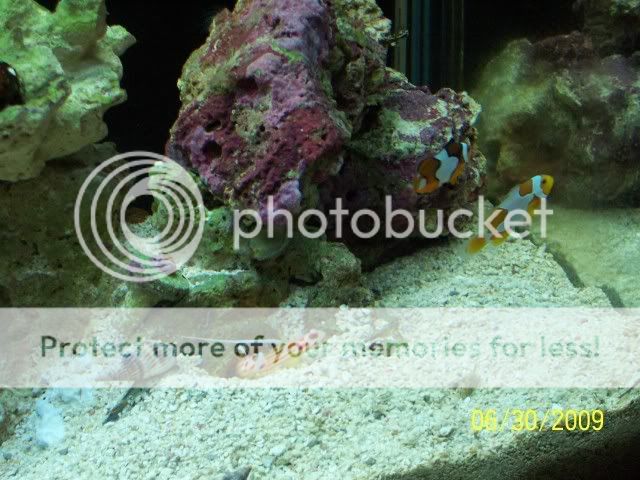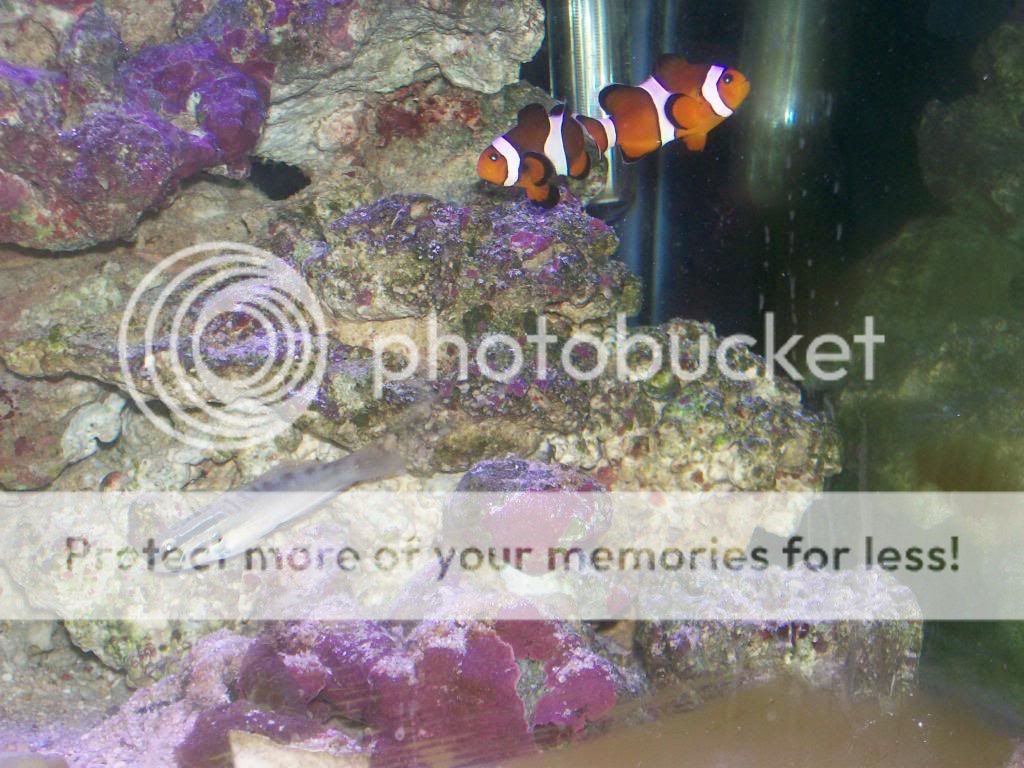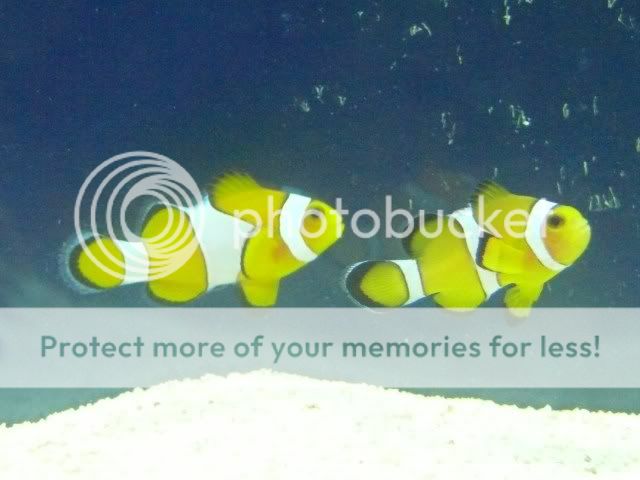So, what does Bob Fenner have to say about the lovable Clowns
Distribution:
Anemonefishes are found throughout the Western Indo-Pacific. Most are collected from the Philippines. None are found in Hawai'i.
Selection:
Of Clownfishes should be a breeze and a pleasure. In the wild they are abundant and easy to capture. All are found in intimate contact with certain species of sea anemones and are easily netted off their "homes" using hand nets, a cup of just by bare hand. None are cyanided; that poison costs money, and is unnecessary.
Sadly, many Clownfishes meet an early end through rough handling, transport and difficulties in general acclimation. There are estimates of some ninety percent mortality en route from capture to distributors and of those remaining, another nine tenths perishing before even reaching the retailer's tanks.
Why? Another cyanide scapegoat? No, in a word, stress.
Being rudely pulled from the "loving arms" of your anemone host (maybe instead of something sounding like "an enemy" we should call them "an ally"), losing the advantage of "cleaning" by your anemone and interaction with members of your species and possibly family, take their toll.
Add to this, chemical and physical insults of polluted holding-water, gill and body "burn" from ammonia build-up in a tiny shipping bag and the trauma of co-mingling with strange and exotic species in a distant clear-sided container and it's a wonder any survive.
So, what can you do? Be a good (= informed & conscientious) consumer!
First of all, buy tank-bred and raised stock if possible. Percula (ocellaris), sebae (clarkii) and tomato (frenatus) clowns are produced in commercial numbers. These may be initially smaller and less-colorful than wild-caught specimens; but they do live. Aquarium-conditioned specimens, tank-raised or not, should be well-fleshed, especially along the back; alert, feeding with no whitish marks on their bodies of fins. If the fish offered are lethargic, hanging out in the corner with drooping, clamped fins, not feeding or have whitish markings....DO NOT BUY THEM! In fact, don't buy a fish from a system with any other fish in it displaying these symptoms. Clowns should be very alert, colorful and fat! They should swim with a wagging motion, and will usually dart to the back of the tank at your first approach, then come eagerly back to the front to look at you.
Size:
Juveniles to sub-adults adapt much better to captive conditions. Some clowns, like Amphiprion ocellaris, may reach up to five inches in the wild. Optimum minimum small sizes for all species are about one inch for wild and three-quarter inch for tank-reared.
Buying for Breeding:
Stock purchased for breeding should be as for most species; buy and raise a group of smaller-than-mature individuals and allow them to pair off. Several species can be sexed externally when large enough, as the females are much heavier-bodied and/or differently colored. Usually when you get two clowns, if you buy one larger than the other, the larger one will turn more aggressive and become the female. For a discussion on structural and color differences and sex-changing (!) see Hoff 1984.
Environmental:
Like many organisms living in close association with invertebrates, Anemonefishes are sensitive to similar chemical and physical conditions and changes.
Acclimating/cleansing dips should be used and be of short duration. Use freshwater with very little or no formalin, copper, malachite, et al.. A dip, not an extended bath.
System temperatures should be in the mid to high seventies (F.)
High water quality, especially keeping low levels of metabolites (proteins, albumen, phenols, nitrogenous compounds, etc.) are advised. Suitable bio-filtration, protein skimming with or without ozone & frequent partial water changes are the rule.
Behavior:
Territoriality:
Anemonefishes can be overtly territorial, in particular where any threat to their host anemone is concerned. It is suggested that they be introduced with their host anemone after other fish tankmates, or provided with their own system. If your clown fish are very large and you want to try adding new specimens; disturbing/re-arranging the physical environment, extra-feeding and a watchful eye for problems are advised. Most other species of fishes are left alone as long as they are previously established, larger or more aggressive, and do not bother the Clownfish's anemone or come too close while the clown's are breeding. Anemonefish can and will attack you and draw blood if so inclined.
Large non-paired adults generally do fight in all but the largest aquaria. Likewise, mixing species of all but juvenile sizes is chaotic. Keep them in separate systems.
To reiterate; aggression can be intense amongst and between species of Anemonefishes. They lock jaws and "bite" each other cichlid-like. To reduce agonistic behavior, provide adequate size quarters, a number of anemones, be leery of mixing sizes and sexes and restrict your collection per tank!. If you want to try mixing adult species, make sure each pair has a large anemone, so they won't fight over anemones. Breeder pairs of some species are kept in ten to twenty gallon systems commercially; yours should be much larger.
Symbiosis with Anemones:
Do they really need an anemone? No, none of them; all have been kept and a few species spawned sans coelenterate; but some species do better then other's in an anemone's absence. A. melanopus, A. frenatus and A. biaculeatus are my top three for toughing it out without their "pals". However, chances of keeping and breeding Anemonefishes in captivity is greatly improved in the presence of host anemones.
The mutually beneficial behavior of clowns and anemones has been well documented and popularized (see Thomas 1978), as has methods of selecting healthy symbiotic anemones. We'd like to reinforce a few points:
If practical, buy an anemone of known symbiotic potential; i.e. one that's displayed with symbiotic clowns, and if possible, buy one with the symbiotic fish desired. Most stores will sell you clowns and anemones that are already living together.
Many species of anemones are unsuitable. (e.g. Condylactis species from Florida, Atlantic carpets). Your clownfish may not easily chemically/physically introduce/communicate/consort with their intended hosts. They may even (gasp!) be consumed by, not with, them!
Some Anemonefish species and individuals of larger sizes do well without anemones, though it has been speculated that they play an important role in removing external parasites besides providing shelter and protection from predators.
Breeding:
Has been a hot topic & covered well elsewhere (Goldstein 1982, Young 1984, Branowski 1985, Lindner 1986). Suffice it here to write that Anemonefishes breed a lot like substrate-spawning neo-tropical cichlids; by cleaning a rocky smooth surface next to or under the base of their host anemone. They deposit eggs, mouth, guard and fan them. When they become free-swimming, the fry are dispersed like planktonic zooplankters.
In captivity their planktonic fry may be fed exclusively on marine rotifers which are easily hatched from eggs. They reproduce throughout the year, laying a few hundred to a few thousand eggs about once a month.
Many species have been spawned and reared in captivity. Amphiprion ocellaris, Amphiprion frenatus and Amphiprion perideraion are most commonly found for sale as tank bred and raised.
Sound Production:
Yes, they are noisy! Clicks and grunts of various types and apparent function have been detailed and is a rich research area. Listen when they are defending their anemone or spawning.
Feeding:
Is not problematical with these fishes. They readily consume dry, prepared, freeze-dried, frozen, live and fresh foods. In the oceans, most rely mainly on zooplankton, with some considerable algal matter found in stomach contents analysis studies. It is suggested that a variety of prepared fresh foods, including vegetable matter be offered on a twice-daily basis. Watch them eat, they will share their food with their anemone.
Diseases:
Anemonefishes are susceptible to many environmental and infectious diseases, and are hosts to numerous species of ectoparasites including isopods, monogenetic trematodes (flukes) tapeworms and roundworms.
Most fish are lost either through the initial collection to end user process, or the first losses of infection, or poor water quality maintenance, or even more regrettably, "treatment". Particularly problematical with these species are initial situations where specimens are compromised/debilitated extensively and rapidly "breaking down" . This combination bacterial, fungal, protozoan mess, so common in newly imported clownfish might be termed "new Anemonefish syndrome". Left unchecked and not, this "syndrome" results in mass mortalities of captured specimens. Among the most often identified pathogens, the algae Oodinium and the protozoans, Cryptocaryon and Brooklynella are common parasites of newly-arrived Anemonefishes. The latter protozoan is not able to be eradicated with copper-based medication. Most efficacious are ones involving formalin/formaldehyde.
Treatment: Prevention, as usual, is the rule.
1) Pick out reasonable stock as detailed in the selection of this article.
2) Do a brief freshwater dip to remove some/most external grunge (a scientific term).
3) Quarantine your new stock if at all possible/practical with or without their anemone for a couple of weeks. Using a mild bacterial medication is suggested; Maracyn II (tm) is excellent.
4) Introduce them to their new viable, permanent aquarium. After acclimation, add a "slime-coat" water conditioner.
Note: If you can't procure quarantine quarters, ask your retailer to hold your charges for you on deposit.
If you find yourself with clownfish with an apparent infection/infestation that seems to necessitate treatment:
1) Check and adjust your water quality. Most "disease" conditions of captive aquatic systems are a result of poor water or system quality. Do not just start pouring a therapeutic into your tank(s). Often, moving the clown's to a different system effects a fast "cure".
2) After quickly doing whatever you can to "re-center" your system, consider further treatments in the following order of priority:
A) Biological: Add a symbiotic anemone if you don't have one or move the fish/es to a system with one. Add a cleaner; a suitable Labroides wrasse (if you can secure a "good one" that has survived the rigors of capture, movement, acclimation to captive conditions), or better a cleaner goby, cleaner shrimp; they work.
B) Physical: Lower your specific gravity. Even with most invertebrates, dropping the specific gravity a few thousandths per day to 1.018-1.019 will not do permanent damage and may shift the balance of favorable conditions to your fishes.
C) Chemicals: Last and least. Be careful. Clown fish are like "canaries in a cave". They tend to be sensitive to the same toxins as their host actinarians (anemones). Copper, other metal salts, organic or metallic dyes, furan compounds, and organophosphate pesticides all have deleterious to disastrous effects. These substances in various formulations, comprise most of the "medicine treatments" available and used in our aquatics interest. They do have some limited, appropriate applications in bare marine treatment tanks. 'Nuff said?
These chemical therapeutics are dangerous and unnecessary with Clownfishes. "Experiment" with them only as a last resort.
Predators:
Allen (1974) lists the following possible aquarium fish families as potential predators:
Muraenidae Moray eels
Synodontidae, Lizardfishes
Serranidae Groupers, Basses
Cirrhitidae Hawkfishes
Lutjanidae Snappers
Scorpaenidae Scorpionfishes, Lionfishes, Turkeyfishes
Actually any tankmate with a large enough mouth may eat your Anemonefish, especially in the absence of a symbiotic anemone. Be forewarned: as their family members, the rest of the damsels, clownfish are common forage fishes.
Summary:
Clownfishes have everything going for them as aquarium specimens. They're hardy, behaviorally interesting, colorful, do well on all types of foods, & if you start with healthy specimens and meet their habitat requirements, they're human-responsive and long-lived.
Bob Fenner

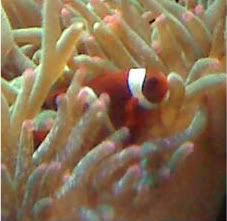




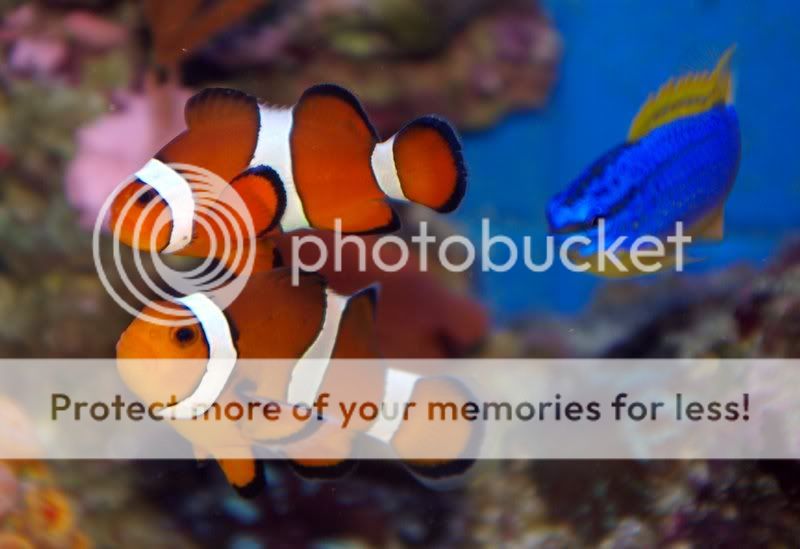
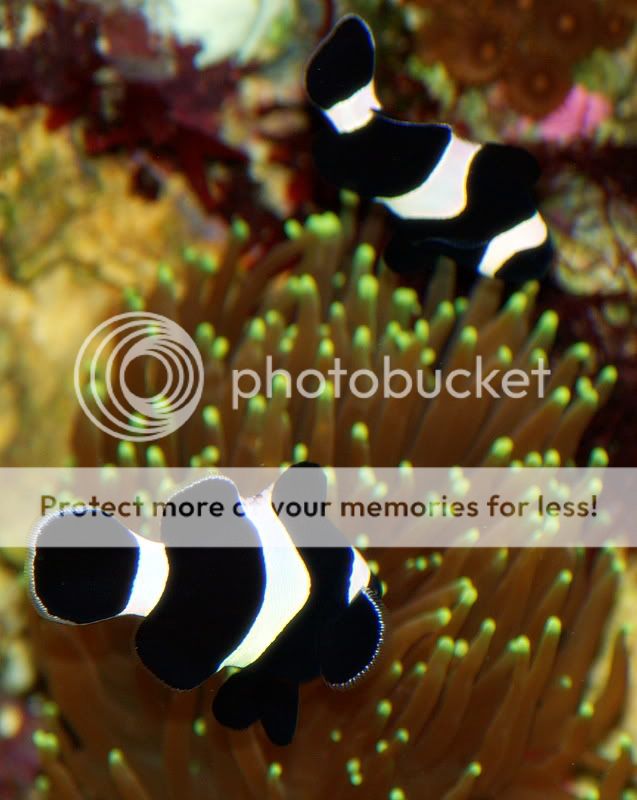
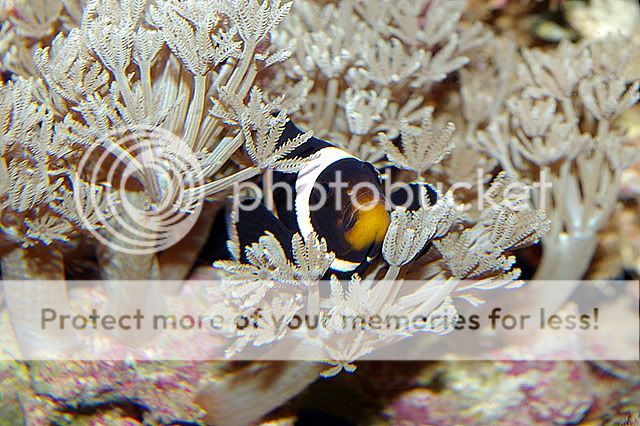
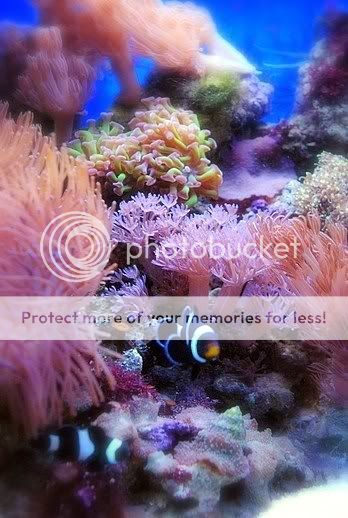
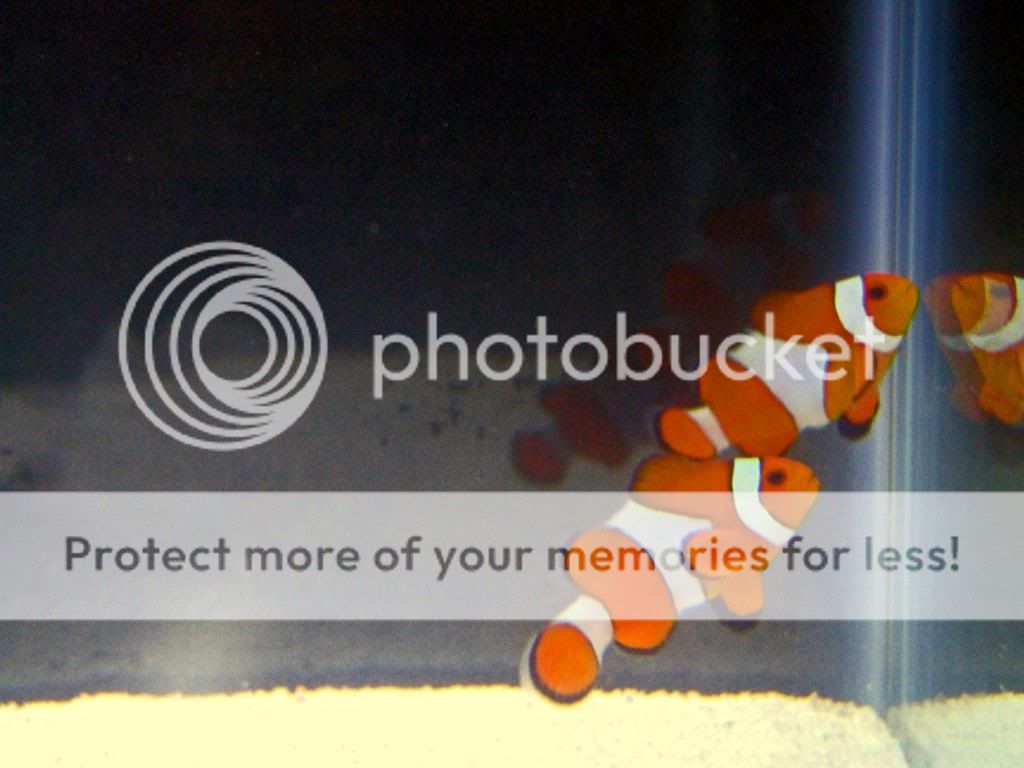
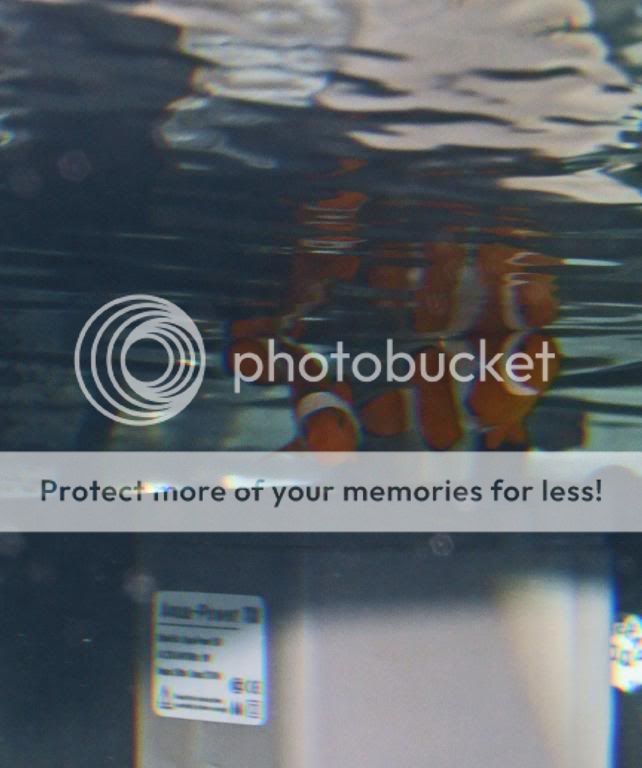
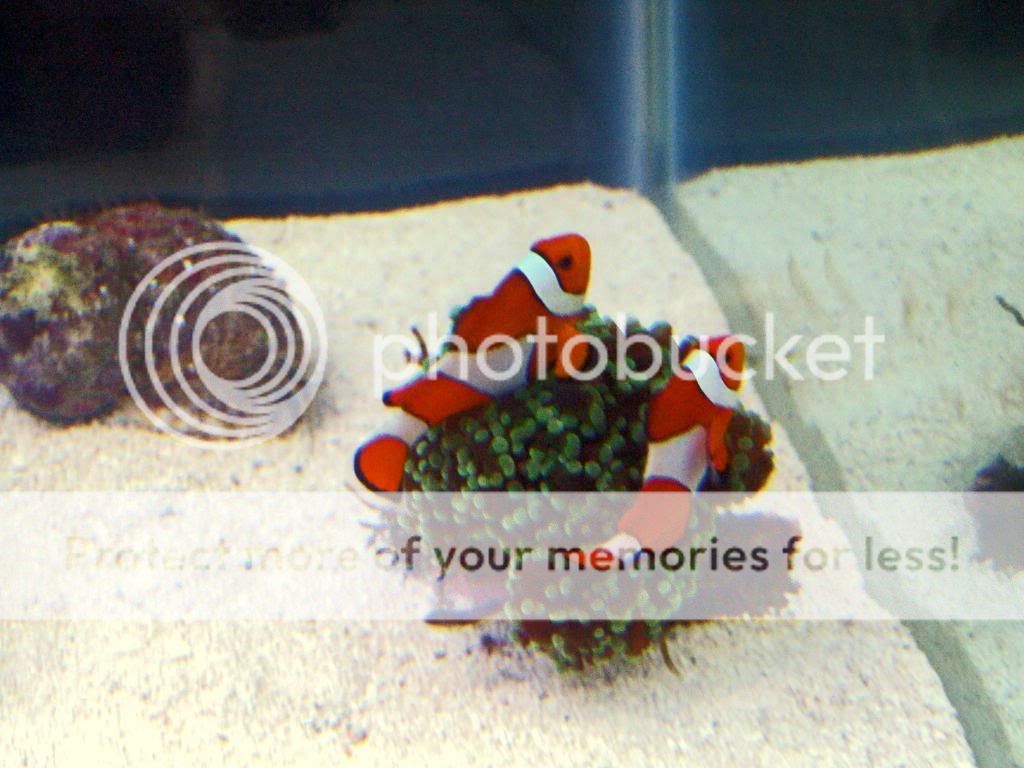
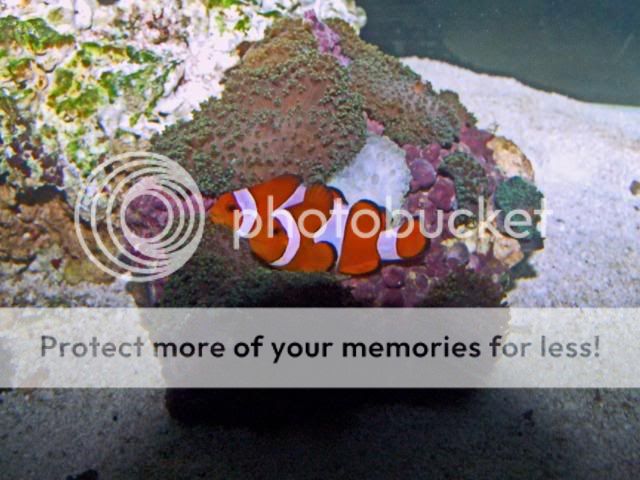
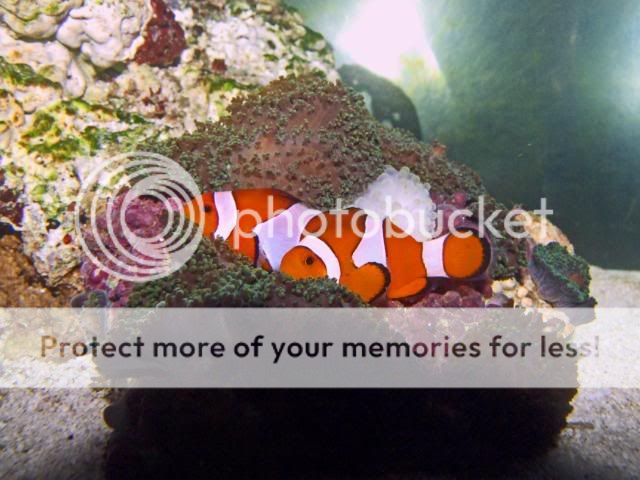
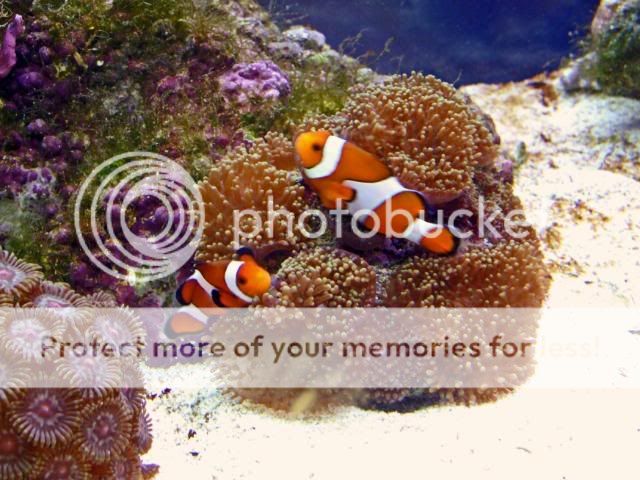
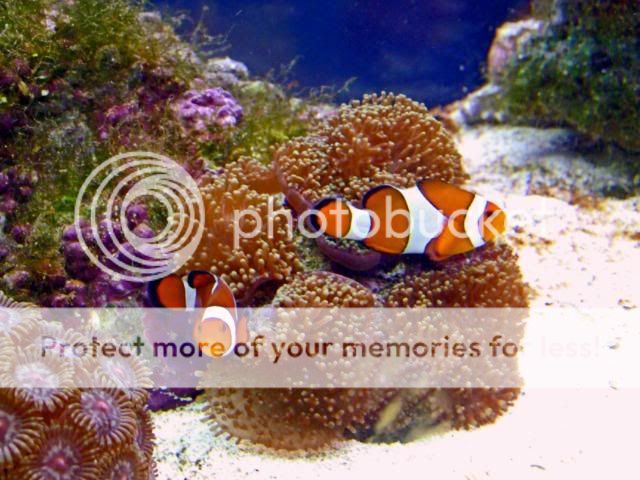
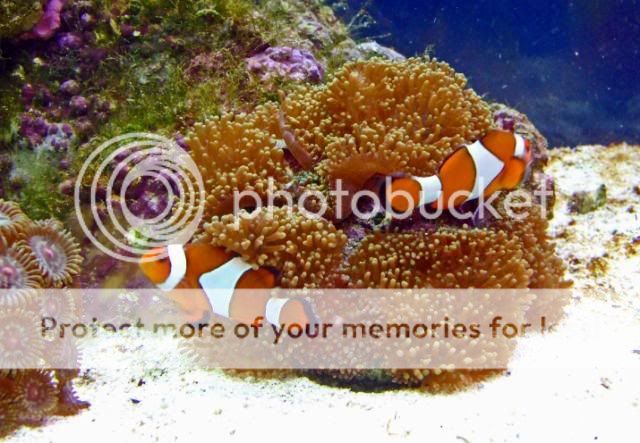
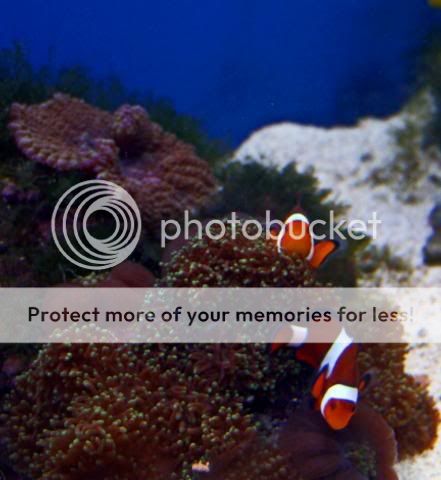
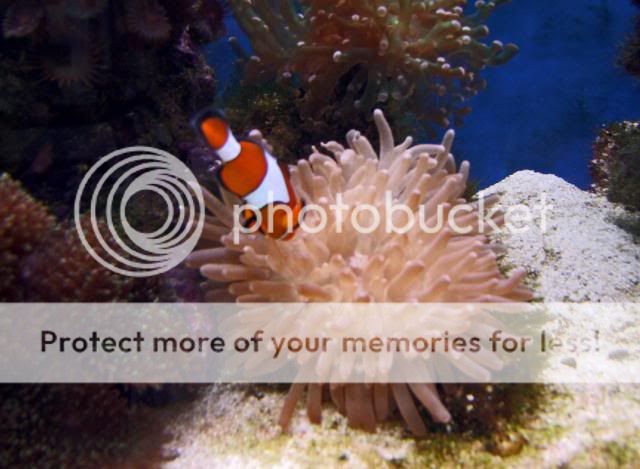
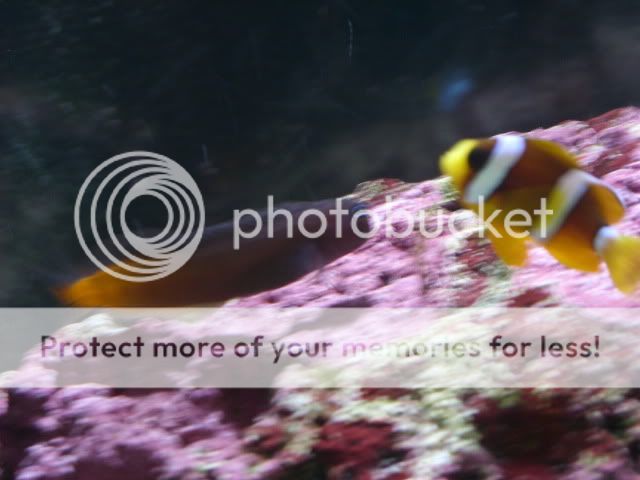
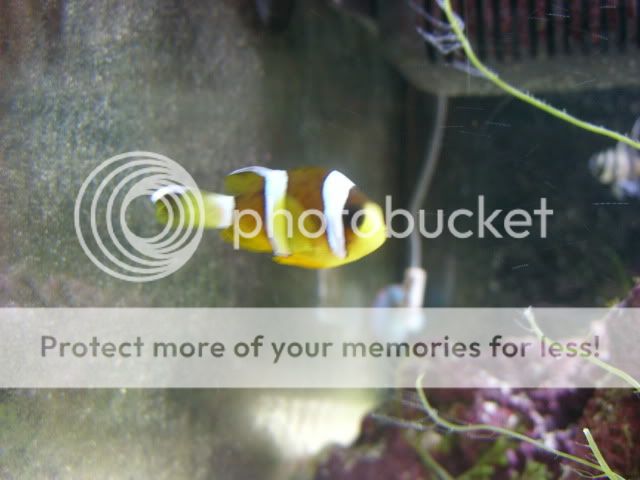

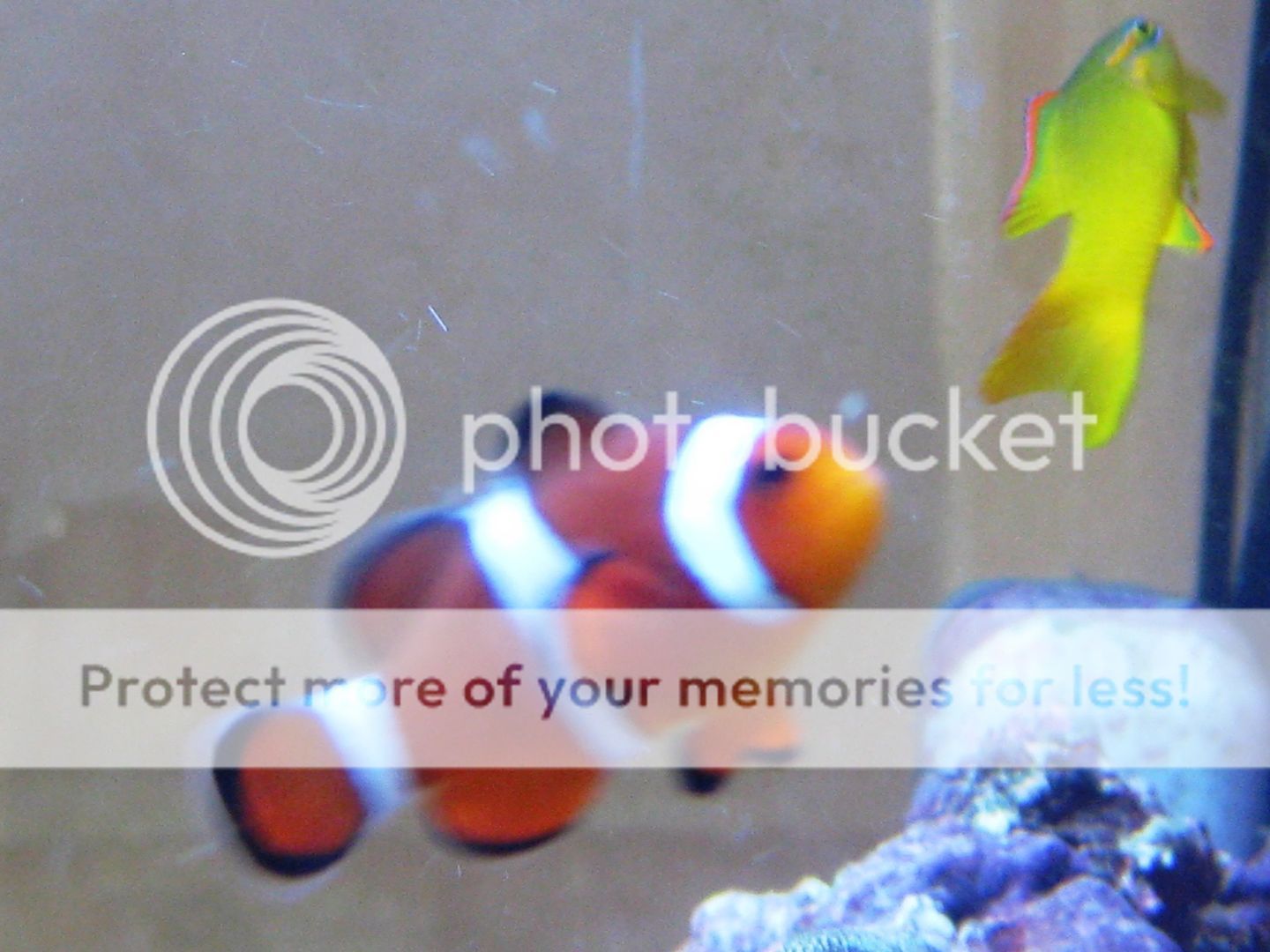
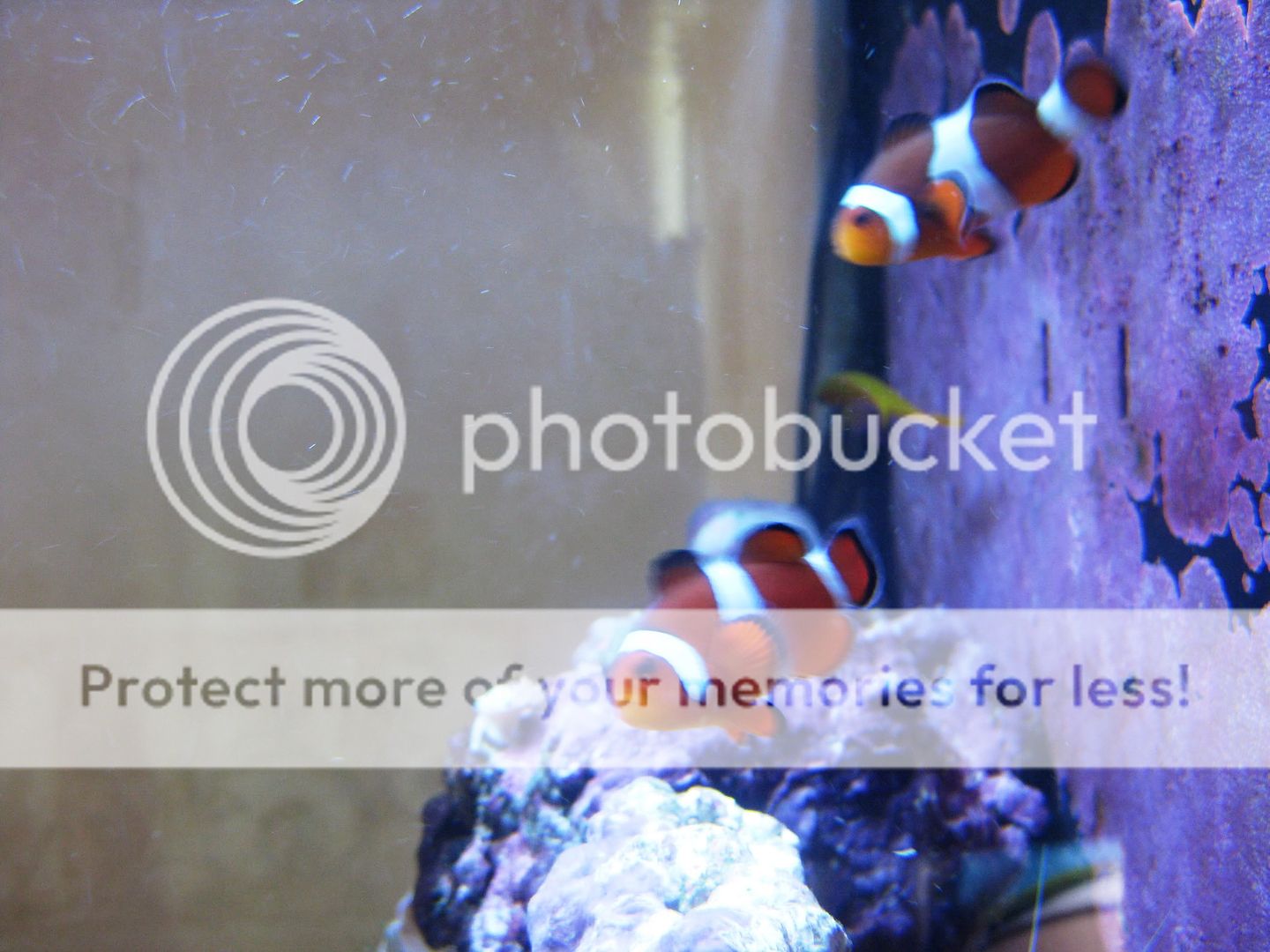

 their toadstool. I was interested to watch them when they went in the big tank to see if the old saying about clowns not going further than 20 cm from their host was true - it's not! Mine roam the whole tank.
their toadstool. I was interested to watch them when they went in the big tank to see if the old saying about clowns not going further than 20 cm from their host was true - it's not! Mine roam the whole tank. )
)

